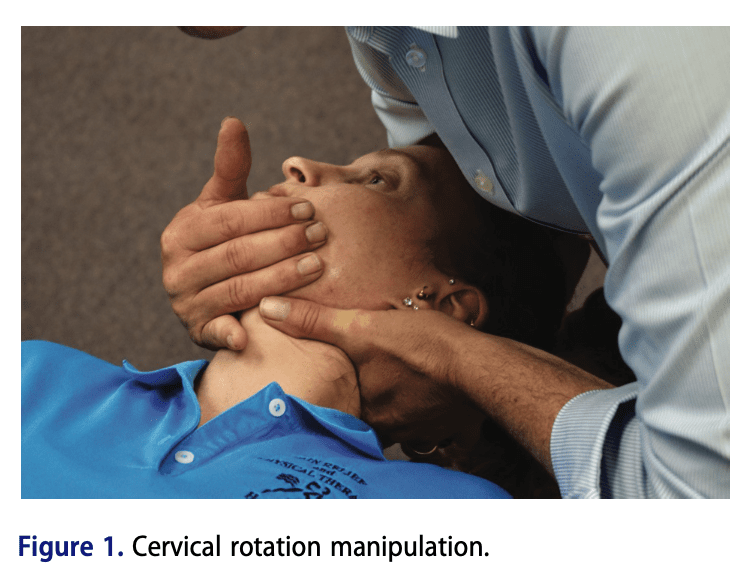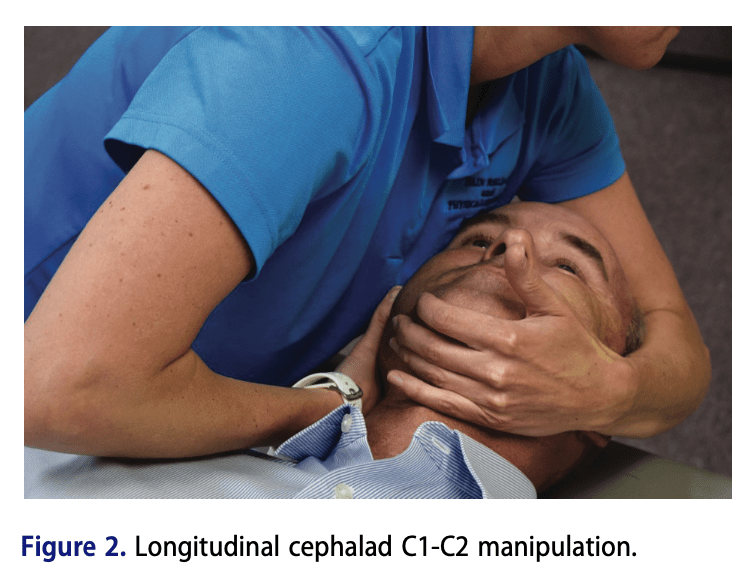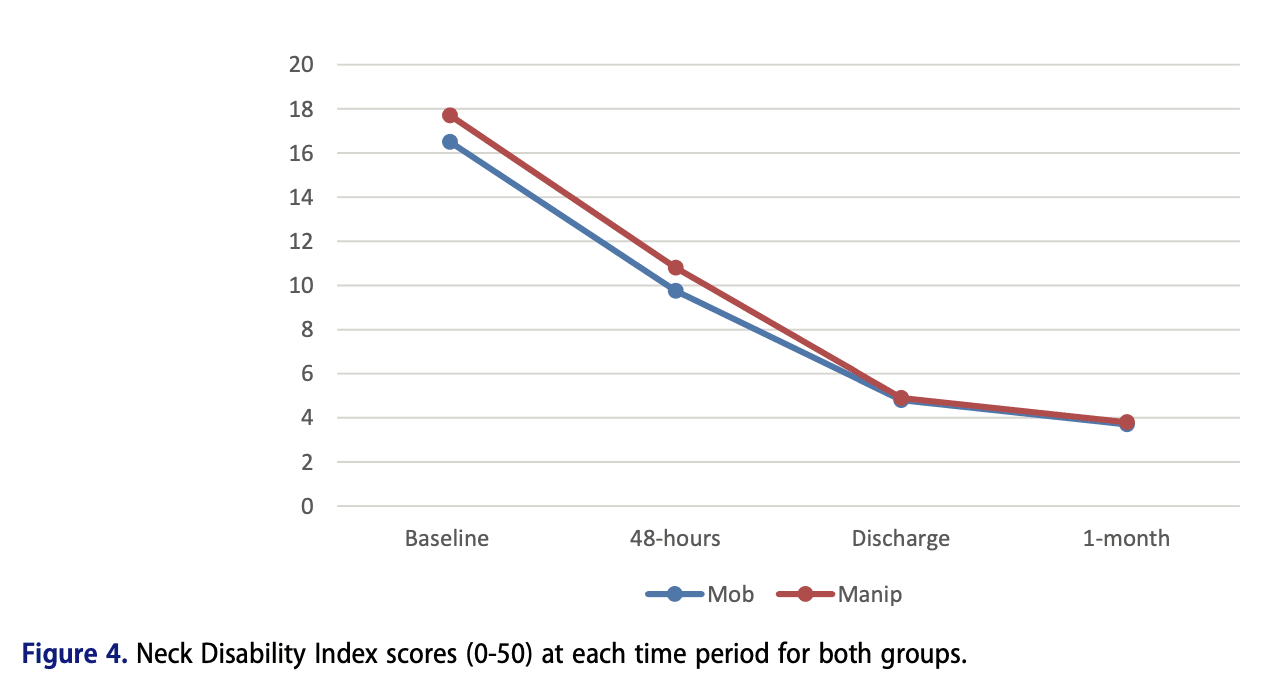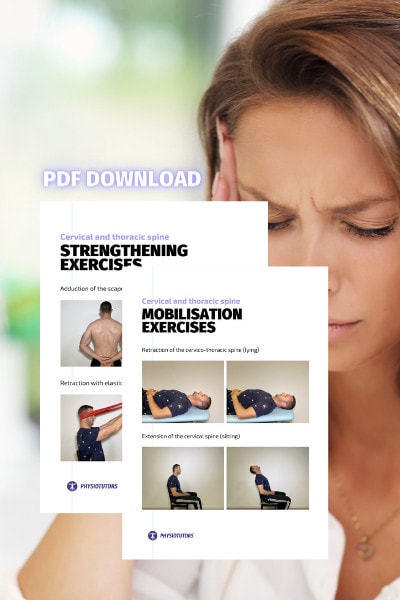Manipulation versus mobilization to the upper cervical spine plus exercise for cervicogenic headache

Introduction
Headache is a complaint that may have a large impact on one’s daily life and activities. In many cases, musculoskeletal components of the upper cervical spine are involved where dysfunctions may lead to the development of cervicogenic headache. Pain is typically felt ipsilateral and may radiate from occipital to frontal. Cervical range of motion is mostly reduced and movement of the neck may replicate or provoke a patient’s symptoms. Recent guidelines, like the Neck Pain: Revision 2017 clinical practice guideline by Blanpied et al. recommend manual therapy and exercise for patients with subacute neck pain with headache but this is defined too broadly. What exactly manual therapy consists of remains unclear for the time being. In the systematic review by Roenz et al. (2018) it was found that manipulation was preferred over mobilization for low back and neck pain when the trial used a prescriptive approach but that these differences did not exist when a pragmatic approach to treatment was implemented. In a pragmatic study, it is aimed to replicate the real life clinical setting as much as possible. As no pragmatic studies examining the effectiveness of manipulation versus mobilization in a population with cervicogenic headache were yet published, the current study did.
Methods
This randomized controlled trial screened patients presenting with a primary complaint of headache between the ages of 18 and 65 for eligibility. After excluding red flags, trauma, cervical spinal stenosis, nervous system involvement or nerve root compression, a diagnosis of cervicogenic headache was made if patients presented with unilateral headache associated with neck pain which was aggravated by neck postures or movements, along with tenderness by manual palpation of the upper cervical spine. Additionally, patients had to report having at least two headaches in the last month, a Neck Disability Index (NDI) score of at least a 20% or more and a pain intensity of at least 2/10 on the Numeric Pain Rating Scale (NPRS).
The primary outcome assessed was the Neck Disability Index at baseline, the second visit (within approximately 2 days), at discharge, and at 1-month follow-up.
Participants were randomized to receive mobilization or manipulation directed at the upper cervical spine. Both groups received an additional home exercise program consisting of 4 exercises.
Subjects were in prone and the therapist assessed by applying a central posterior to anterior force to the spinous process of the patient at the C2 and C3 level, then a unilateral posterior to anterior on either the articular pillar or lamina body C2 and C3 as well as the lateral mass of C1, with the intent of reproducing the patient’s comparable sign. Once the therapist identified the specific level and location, this segment was mobilized at that level for 30 seconds. This mobilization was repeated twice using smooth/rhythmic oscillations. The same procedure for determining the segment was performed in the manipulation group but instead of mobilizing, the therapist performed either a localized cervical rotation manipulation or a longitudinal cephalad C1 and C2 manipulation. As the RCT was a pragmatic trial, the treating clinician was able to select the manipulation technique (manipulation group) which seemed most appropriate for the individual patient given their clinical presentation.


Results
Forty-five patients with cervicogenic headache (mean age 47.8 ± SD 16.9 years) were randomly assigned to receive either manipulation or mobilization. At baseline, both groups were comparable. The results showed that both groups improved and that there was no significant difference between groups over time. The improvements in both groups exceeded the minimal detectable change of 5.5 points on the NDI, which is the threshold for individuals with cervicogenic headache. So it appears that there was no difference in effectiveness of manipulation versus mobilization when the techniques are chosen pragmatically.


Questions and thoughts
Besides the mobilizations or manipulations, participants in both groups also received an additional home exercise program. The authors described that the adherence to the program was monitored. Unfortunately, no data on adherence to this program was provided. Although the primary objective of this study was to compare the effectiveness of manipulation versus mobilization, it could have been interesting to see if there were differences in patients adhering to the home exercise program versus those who didn’t. Maybe the effects were higher in the groups with more adherers, and maybe the exercise program had important effects on the decrease in NDI.
The effectiveness of manipulation versus mobilization was studied, but no true control group was included. Therefore, it is unclear whether the results are based on the study procedures alone and placebo effects or the natural history may have caused the differences in disability.
Talk nerdy to me
Some good aspects of the study include that it was registered and sample size calculations were done a priori. The treating therapists were trained to perform the study procedures and to ensure all proceedings were performed in a standardized way. Allocation of participants to the groups was concealed and the therapist was blinded to the baseline examination findings as another examiner obtained the baseline measurements.
The trial referred to the clinical practice guideline by Blanpied et al. to justify the use of manual therapy techniques. However, this guideline also recommends using C1-C2 self-SNAG exercises which were not included in the home exercise program. But in clinical practice, it may be interesting to give patients a self-management technique besides the passive manual therapy techniques as used in this study.
An effect size of 0.2 was used for sample size calculation, which seems low. However, it is plausible as it can be expected that none of those treatments would largely outperform the other. The required sample in each group was 24 subjects, yet only the mobilization group fulfilled the requirement. The manipulation group consisted of 21 subjects only, but as the study found no significant findings, it is unlikely that an additional 3 subjects would have made an important difference.
Take home messages
No differences in the effectiveness of manipulation versus mobilization could be observed. Therefore, both techniques can be used to treat patients presenting with cervicogenic headache in clinical practice. Both manipulations and mobilizations were effective in decreasing disability as measured with the Neck Disability Index, but as no true control group was implemented in the study, we are unsure if the observed effects can be solely attributed to the manual therapy techniques used. This should be investigated further on to exclude that the effects were influenced by placebo and/or by the natural history of the condition.
Reference
100% FREE HEADACHE HOME EXERCISE PROGRAM
Download this FREE home exercise program for your patients suffering from headaches. Just print it out and hand it to them for them to perform these exercises at home



